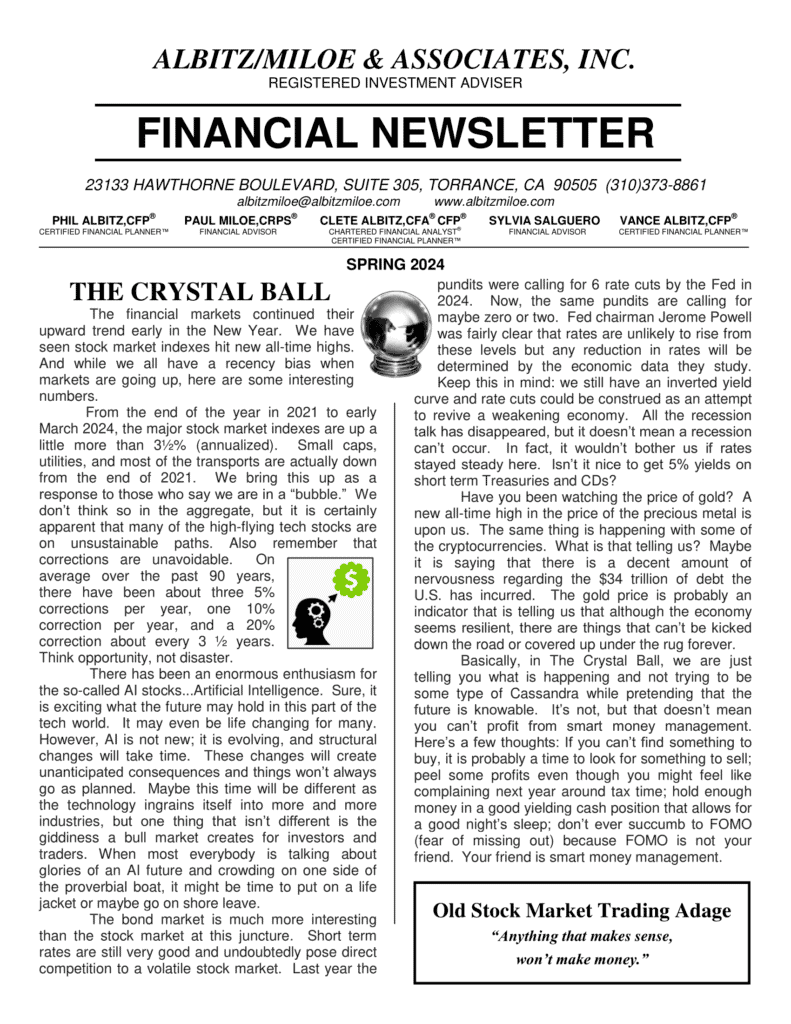1. The Fed Cutting Interest Rates
We aren’t in a recession, my stock portfolio did well in 2023, and recent inflation numbers came in high. But the Fed says they will probably cut rates this year. Why?
There are no guarantees that the Federal Reserve will cut rates to the extent they mentioned at the end of 2023. Having said that, the Fed has two jobs: maximize employment and maintain price stability. When inflation is above the Federal Reserve’s 2% target, as has been the case for the last two years, the Fed focuses almost entirely on bringing it down. But when inflation is only slightly above the Fed’s target, which is likely to be the case in 2024, the Fed can take a more balanced approach. Rates will most likely remain much higher this year than they were before 2020 to get inflation under control. But a few rate cuts would reduce the risk of an unnecessary recession. The extent of time for which rates are very elevated is crucial: it determines how many households and businesses must borrow at those high rates. The reason stocks pushed higher at the end of 2023 and a “soft-landing” is possible is because the Fed will probably cut rates.
2. Consumer Sentiment
If the economy is doing so well, why do so many people say it’s bad?
The two main reasons are everyday price increases and economic disparities. Consumer sentiment fell to an all-time low when CPI (consumer price index) inflation peaked at 9% in June 2022. Although inflation has slowed significantly, prices are still much higher than they were before the pandemic, including in goods categories where prices had been little changed over the prior two decades; and these prices are unlikely to return to pre-Covid levels. To go back to the prices we saw five years ago, it would likely take a historically painful recession to bring in that degree of deflation. And the Fed would lean hard against such an outcome because it targets inflation, not price levels. In other words, past inflation is mostly water under the bridge for the Fed. It only wants to ensure that, going forward, prices increase by around 2% per year. So sentiment is likely to normalize only gradually, as consumers get used to new, higher price levels.
3. Travel
The airport was jam-packed on my flights during the holidays. I guess air travel is back?
It most certainly is. Airport traffic finally caught up to pre-pandemic levels at the beginning of 2023. Then, starting around September, air travel started to consistently outpace 2019 levels. Air travel is a good measure of the pulse of the consumer because a lot of it comes from discretionary income. Further more, travel in general is linked to other types of discretionary spending, such as hotels, restaurants, and entertainment.
4. Consumer Spending
What have consumers been spending on?
In the early stages of the post-pandemic reopening, consumer spending shifted heavily back into services because there was a lot of pent-up demand for activities we missed out on: travel, live entertainment, and different types of medical care. Right now, durable goods spending is outpacing services. There are probably a few reasons for this shift. First, after the burst in inflation because of supply chain issues, durable goods prices have fallen. Second, the supply disruptions caused a lot of pent-up demand, particularly for cars. As supply has normalized and production has increased, auto sales have picked up sharply. Third, hybrid work is widely accepted and supportive of such goods spending. Even one day of work from home per week decreases spending on services, such as restaurants, transit, and laundry, by up to 20% and increases spending on durables goods, such as furniture and laptops. After all, we all need a comfortable home setup these days.
5. National Debt
I’m worried about the national debt. When is it going to stop climbing? Are my grandchildren going to be responsible for a big tax bill?
The national debt is probably not going to stop climbing any time soon. In 2023, the national deficit roughly doubled after accounting for some quirks around changes to student loan forgiveness. Deficits add to the national debt each year. As long as the US federal government keeps running deficits, we will keep seeing the national debt climb. It is very unlikely that the US will start running a surplus any time soon. First, interest expenses on the debt are much higher than they were five years ago. Over the last 12 months, interest expenses have totaled around 950bn, or 3.4% of GDP, which is more than spending on national defense. This number should continue to grow as new debt is accrued and existing debt is refinanced over the coming years at higher rates. Second, a large portion of spending – Social Security and Medicare – is politically almost untouchable. Spending on these programs totaled nearly $2.2tn in 2023 or 8.0% of GDP. An aging population means that the costs associated with these programs should continue to climb. As a result, the national debt is set to continue its upward march. The Congressional Budget Office expects public debt to increase from roughly 100% to around 120% of GDP over the next 10 years.
At some point, we need to address the national debt issue.
The debt-to-GDP ratio will become too high one day and will have big economic implications. It can lead to higher interest rates, crowding out private investment and lowering the productive capacity of the economy. Additionally, it can lead to fiscal dominance, where the Fed loses its ability to control inflation. The US can run higher debt-to-GDP ratios than most other countries without triggering these adverse scenarios for a variety of reasons, including the dollar’s role as the world’s reserve currency. The fact that there is almost always demand for dollar-denominated assets helps keep a lid on US interest rates.
The well-known Penn-Wharton Budget model estimates that a debt-to-GDP ratio of 200% is the threshold where things get messy. To prevent this threshold from being breached, Congress would need to make meaningful changes to the current fiscal stance-e.g., higher taxes and entitlement cuts. The size of the required changes increases the longer Congress delays, but there appears to be little appetite among lawmakers at the moment to address growing concerns over spending. The first test will likely be the expiration of the 2017 Tax Cuts and Jobs Act at the end of 2025.
6. Home Prices
I’m also worried about home prices. I want to buy, but should I just keep renting?
Renting is still cheaper than buying in most major cities. Housing is arguably the most rates-sensitive sector of the economy. So it isn’t surprising that aggressive Fed hikes pushed mortgage rates up to around 8% in 2023, which is a nightmare for most potential buyers (compared to 3%). In addition, high mortgage rates have made current homeowners reluctant to move (you can’t take your mortgage with you), tightening the supply of existing homes and putting a floor under home prices. Post pandemic, both options of renting and buying have become more expensive. But renting is still more affordable than buying in virtually every major city. On a national basis, rents have increased from 23% to 26% of median US household income, while the ratio of mortgage payments to income has grown from 19% to 32%.
The good news is that mortgage rates have been falling since November. Fed rate cuts should ease the mortgage market further. So while renting is still probably the cheaper option, the buying environment should improve going forward.
7. The Job Market
I’m considering switching jobs. I hear the job market is cooling off.
It’s getting harder to switch jobs, especially for better pay. Job growth has slowed down this year. In recent months, nearly all the jobs added in the economy have been in a few sectors: health care & private education, leisure & hospitality, and government. These sectors were the slowest to recover from the pandemic. Accordingly, wage growth for job switchers has also declined significantly. Having said that, the labor market is still strong, and you could still land a great new job.
For a comprehensive review of your personal situation, always consult with a tax or legal advisor. Neither Cetera Advisor Networks LLC nor any of its representatives may give legal or tax advice





